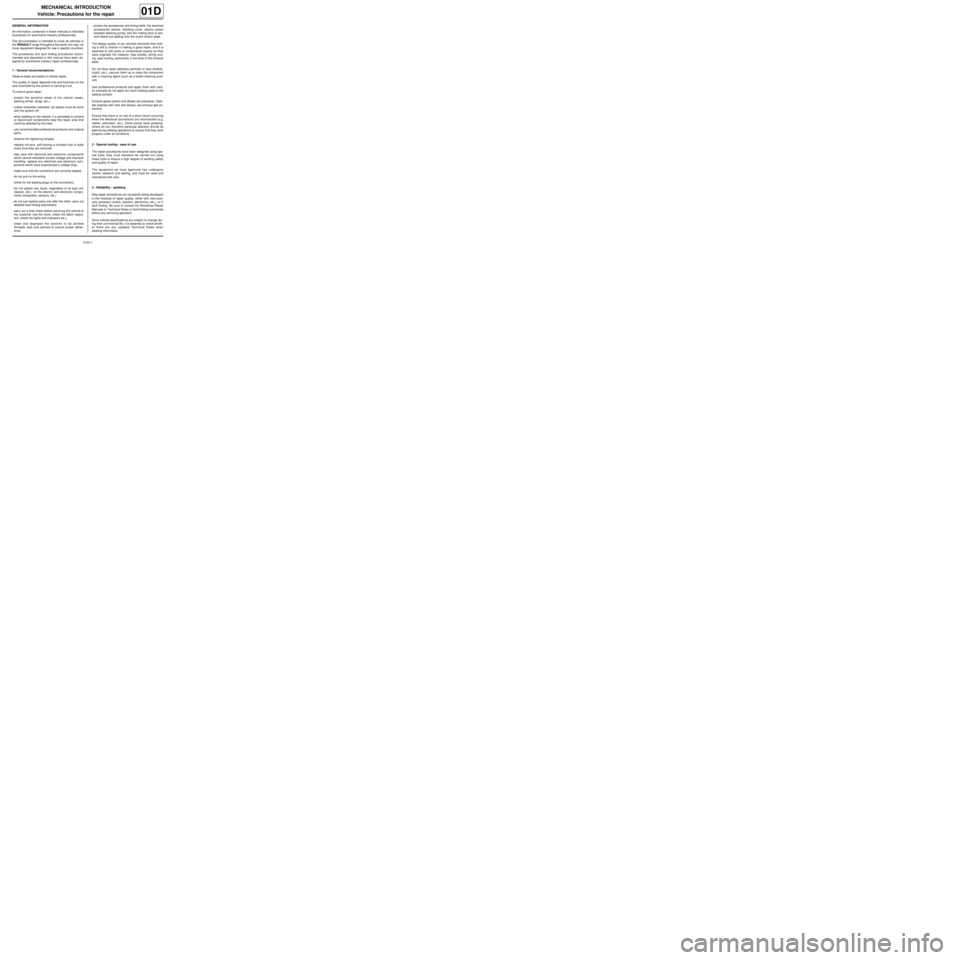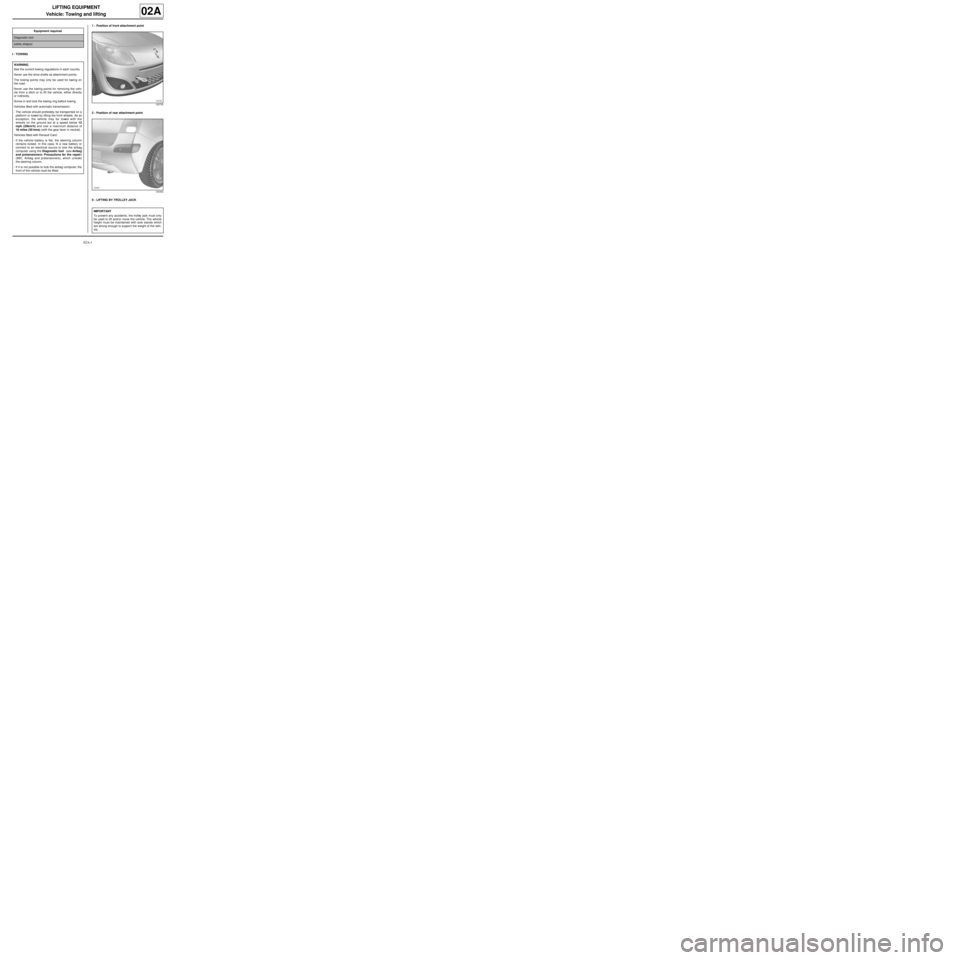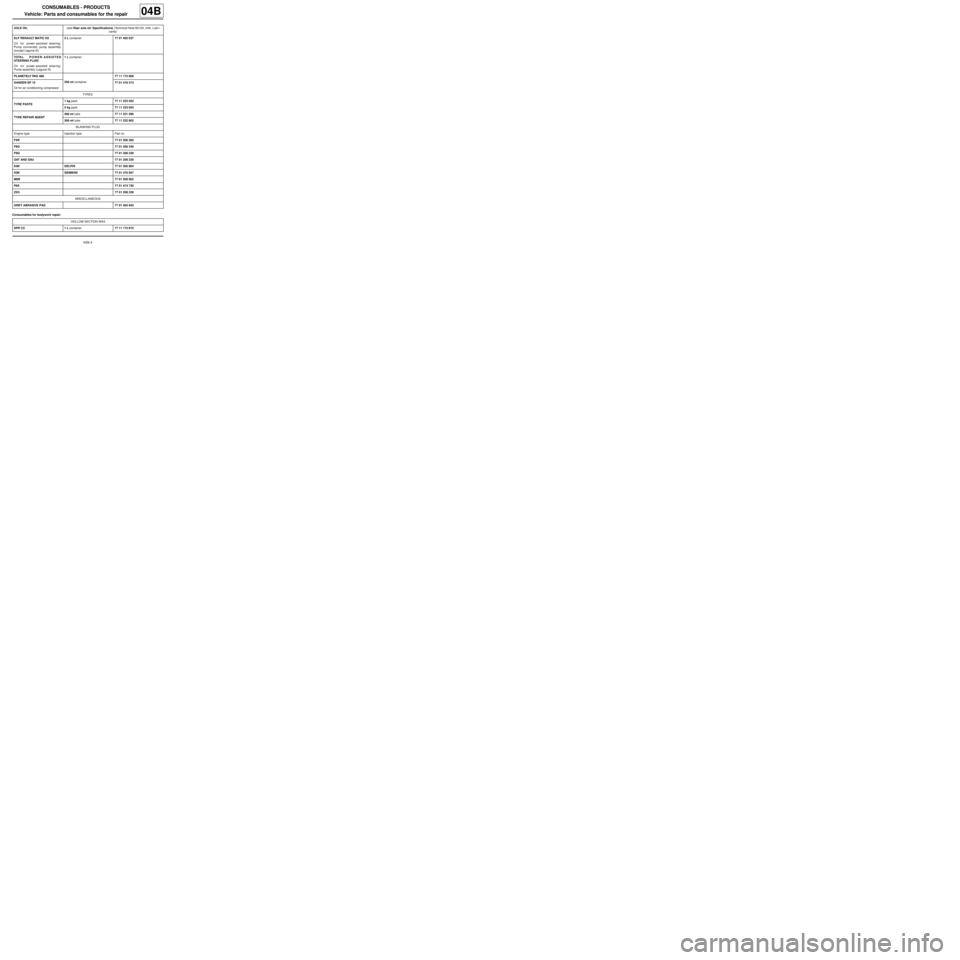steering RENAULT TWINGO RS 2009 2.G General Vehicle Information Workshop Manual
[x] Cancel search | Manufacturer: RENAULT, Model Year: 2009, Model line: TWINGO RS, Model: RENAULT TWINGO RS 2009 2.GPages: 46
Page 14 of 46

01D-1
MECHANICAL INTRODUCTION
Vehicle: Precautions for the repair
01D
GENERAL INFORMATION
All information contained in these manuals is intended
exclusively for automotive industry professionals.
The documentation is intended to cover all vehicles in
the RENAULT range throughout the world, but may not
cover equipment designed for use in specific countries.
The procedures and fault finding procedures recom-
mended and described in this manual have been de-
signed by automotive industry repair professionals.
1 - General recommendations
Observe basic principles of vehicle repair.
The quality of repair depends first and foremost on the
care exercised by the person in carrying it out.
To ensure good repair:
-protect the sensitive areas of the vehicle (seats,
steering wheel, wings, etc.),
-unless otherwise indicated, all repairs must be done
with the ignition off,
-when welding on the vehicle, it is advisable to remove
or disconnect components near the repair area that
could be affected by the heat,
-use recommended professional products and original
parts,
-observe the tightening torques,
-replace roll pins, self-locking or bonded nuts or bolts
every time they are removed,
-take care with electrical and electronic components
which cannot withstand excess voltage and improper
handling; replace any electrical and electronic com-
ponents which have experienced a voltage drop,
-make sure that the connectors are correctly clipped,
-do not pull on the wiring,
-check for the sealing plugs on the connectors,
-Do not splash any liquid, regardless of its type (oil,
cleaner, etc.), on the electric and electronic compo-
nents (computers, sensors, etc.)
-do not just replace parts one after the other, carry out
detailed fault finding beforehand,
-carry out a final check before returning the vehicle to
the customer (set the clock, check the alarm opera-
tion, check the lights and indicators etc.),
-clean and degrease the sections to be bonded
(threads, stub axle splines) to ensure proper adher-
ence,-protect the accessories and timing belts, the electrical
accessories (starter, blanking cover, electric power
assisted steering pump) and the mating face to pre-
vent diesel fuel spilling onto the clutch friction plate.
The design quality of our vehicles demands that noth-
ing is left to chance in making a good repair, and it is
essential to refit parts or components exactly as they
were originally (for instance: heat shields, wiring rout-
ing, pipe routing, particularly in the area of the exhaust
pipe).
Do not blow away asbestos particles or dust (brakes,
clutch, etc.), vacuum them up or clean the component
with a cleaning agent (such as a brake cleaning prod-
uct).
Use professional products and apply them with care,
for example do not apply too much sealing paste to the
sealing surface.
Exhaust gases (petrol and diesel) are pollutants. Oper-
ate engines with care and always use exhaust gas ex-
tractors.
Ensure that there is no risk of a short circuit occurring
when the electrical connections are reconnected (e.g.
starter, alternator, etc.). Some points need greasing,
others do not, therefore particular attention should be
paid during refitting operations to ensure that they work
properly under all conditions.
2 - Special tooling - ease of use
The repair procedures have been designed using spe-
cial tools; they must therefore be carried out using
these tools to ensure a high degree of working safety
and quality of repair.
The equipment we have approved has undergone
careful research and testing, and must be used and
maintained with care.
3 - Reliability - updating
New repair procedures are constantly being developed
in the interests of repair quality, either with new prod-
ucts (emission control, injection, electronics, etc.), or in
fault finding. Be sure to consult the Workshop Repair
Manuals or Technical Notes or fault finding summaries
before any servicing operation.
Since vehicle specifications are subject to change dur-
ing their commercial life, it is essential to check wheth-
er there are any updated Technical Notes when
seeking information.
Page 20 of 46

02A-1
LIFTING EQUIPMENT
Vehicle: Towing and lifting
02A
I - TOWING1 - Position of front attachment point
2 - Position of rear attachment point
II - LIFTING BY TROLLEY JACK Equipment required
Diagnostic tool
safety strap(s)
WARNING
See the current towing regulations in each country.
Never use the drive shafts as attachment points.
The towing points may only be used for towing on
the road.
Never use the towing points for removing the vehi-
cle from a ditch or to lift the vehicle, either directly
or indirectly.
Screw in and lock the towing ring before towing.
Vehicles fitted with automatic transmission:
-The vehicle should preferably be transported on a
platform or towed by lifting the front wheels. As an
exception, the vehicle may be towed with the
wheels on the ground but at a speed below 12
mph (20km/h) and over a maximum distance of
18 miles (30 kms) (with the gear lever in neutral).
Vehicles fitted with Renault Card:
-If the vehicle battery is flat, the steering column
remains locked. In this case, fit a new battery or
connect to an electrical source to lock the airbag
computer using the Diagnostic tool (see Airbag
and pretensioners: Precautions for the repair)
(88C, Airbag and pretensioners), which unlocks
the steering column.
-If it is not possible to lock the airbag computer, the
front of the vehicle must be lifted.
120735
120450
IMPORTANT
To prevent any accidents, the trolley jack must only
be used to lift and/or move the vehicle. The vehicle
height must be maintained with axle stands which
are strong enough to support the weight of the vehi-
cle.
Page 39 of 46

04B-4
CONSUMABLES - PRODUCTS
Vehicle: Parts and consumables for the repair
04B
Consumables for bodywork repair:AXLE OIL (see Rear axle oil: Specifications) (Technical Note 6012A, 04A, Lubr i-
cants)
ELF RENAULT MATIC D2
Oil for power-assisted steering:
Pump connected, pump assembly
(except Laguna III)2 L container77 01 402 037
TOTAL POWER-ASSISTED
STEERING FLUID
Oil for power-assisted steering:
Pump assembly (Laguna III)1 L container
PLANETELF PAG 488
250 ml container77 11 172 668
SANDEN SP 10
Oil for air conditioning compressor77 01 419 313
TYRES
TYRE PASTE1 kg pack77 11 223 052
5 kg pack77 11 223 053
TYRE REPAIR AGENT400 ml tube77 11 221 296
300 ml tube77 11 222 802
BLANKING PLUG
Engine type Injection type Part no.
F5R77 01 206 382
F8Q77 01 206 340
F9Q77 01 208 229
G9T AND G9U 77 01 208 229
K9K DELPHI 77 01 206 804
K9K SIEMENS 77 01 476 857
M9R 77 01 209 062
P9X77 01 474 730
ZD377 01 208 229
MISCELLANEOUS
GREY ABRASIVE PAD 77 01 405 943
HOLLOW SECTION WAX
SPR CC 1 L container77 11 172 672